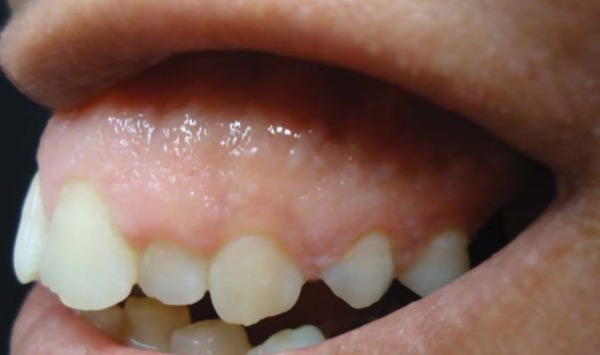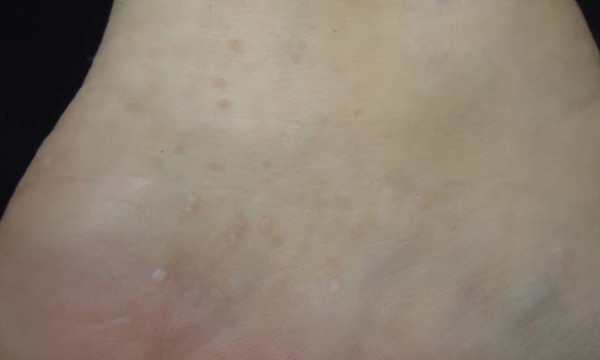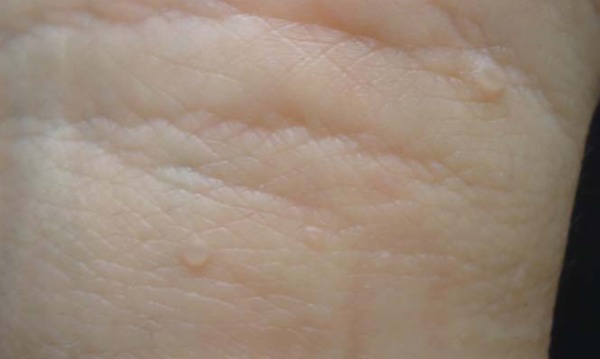Abstract
Cowden's disease or multiple hamartoma syndrome is an autosomal dominant inherited disease and the main dermatological features are facial trichilemmomas (hamartomas of the follicular infundibula), oral fibroma and benign acral keratoses. The importance of this disease lays in the increased susceptibility to malignization of some lesions, especially breast, thyroid and genitourinary tract. Despite its varied phenotypic expression, this disease is generally unknown. Consequently, many cases are undiagnosed or diagnosis comes at a late stage, which reinforces the importance of an early investigation of the disease so the patient may have periodic check-ups to discover and treat malignancies.
Keywords: Hamartoma syndrome, multiple; Mouth diseases; Neoplasms
Abstract
A doença de Cowden ou síndrome dos hamartomas múltiplos é de transmissão autossômica dominante cuja tríade dermatológica compõem-se de triquilemomas faciais múltiplos (hamartomas do infundíbulo folicular), fibromas orais e queratoses acrais benignas. A importância desta doença está no aumento da susceptibilidade a malignização de algumas lesões, especialmente de mama, tireóide e trato genito-urinário. Apesar da expressão fenotípica variada, esta doença é geralmente desconhecida. Consequentemente, muitos casos não são diagnosticados ou o diagnóstico vem tardiamente, o que ressalta a importância do diagnóstico precoce da doença para que o paciente possa ser monitorado periodicamente para diagnóstico e tratamento precoce de doenças malignas.
CASE REPORT
Thirty-four year old white female patient, presented with facial lesions for the past 14 years. At the exam 2-3 mm normochromic papules were distributed mainly around the eyes, nostrils and mouth and temporal areas. Also, clustered normochromic papules with a plain and smooth surface were present in the dorsal area of the tongue and gingival areas. Other visible lesions were: palmoplantar keratosis, with central depression and extension to the wrists; one papular, non-pedunculated smooth-surfaced lesion on the shoulder and flat wart-like lesions on the dorsal region of hands and lateral parts of the feet (Figures 1 to 3). This patient also had macrocephaly, ogival palate, adenoid facies and palpable thyroid nodules. The largest nodule was biopsied and cytological exam showed only hyperplasic cells without evidence of malignancy.
FIGURE 1.

Flat, smooth-surfaced normochromic papules on the upper gum
FIGURE 3.

Keratotic papules on the lateral area of the foot and medial malleolus, some are normochromic and others slightly erythematous, resembling flat warts
Anatomopathological exam of a facial papule showed unspecific alterations and the shoulder lesion analysis resulted in sclerotic fibroma. We did not observe koilocytosis on the flat wart-like lesions. Electrocoagulation sessions on the facial papules provided esthetic improvement of the lesions.
DISCUSSION
Cowden's disease (DC) or multiple hamartoma syndrome is a rare genodermatosis, with dominant autosomal penetrance and variable expression, which would explain the fact that this disease is underdiagnosed.1,2 It is characterized by the presence of hamartomas in several tissues, some congenital abnormalities, besides carrying an increased risk for malignancies.1 About 80% of the cases present with germline mutations, causing the inactivation of pathways regulated by suppressor gene PTEN, also present in other similar syndromes.3
Alterations in oral mucosa and skin are usually the first signs and most of the time they precede tumoral complications in other sites.4 The most characteristic mucocutaneous lesions are facial trichilemmomas surrounding natural orifices, oral papillomas, and acral keratoses.2,4 Typical oral papillomas usually have between one and three millimeters and affect gingiva, tongue dorsum, oral mucosa, palate, alveolar endothelium and tonsillar fossa. The histological features are quite unspecific, presenting mostly with fibroepithelial hyperplasia.2 Sclerotic fibroma, also known as, circumscribed storiform collagenoma, may be present during the evolution of the disease.5 The patient reported here presented with lesions that were characteristic of the syndrome. The fact that the histopathological examination did not show alterations in the trichilemmomas was expected, since they represent only 50% of the facial lesions in patients with DC. As for the extracutaneous involvement, thyroid is the most commonly affected organ (60%), with thyroid adenomas being the most diagnosed benign tumors in this syndrome.6 The risk for non-medullar thyroid carcinoma is between 3 and 10%. Breast alterations include benign lesions such as fibrocystic disease as well as carcinomas. Breast malignancy is estimated to affect 25% to 50% of the patients with DC, while for the general population this rate is 12%. Other alterations are seen in the gastrointestinal tract (polyposis, diverticulosis) and ovaries (cysts and tumors).6,7 A third of the patients presents skeletal defects such as enlargement of the cranial diameter, adenoid facies, kyphoscoliosis, pectus excavatum, larger hands and feet and syndactyly.2 Due to the rarity of this disease, literature recommendation as to its proper treatments is still lacking.1 Our patient had several manifestations of DC. As with this woman, that search medical attention because of the skin alterations, dermatologic findings are very important as a clue to DC, a disease that may potentially reveal internal malignancies. Multidisciplinary management is essential. Our patient is still in regular follow-up with several specialists including gynecologists, endocrinologists, gastroenterologists and medical geneticists. The use of rapamycin in mice, genetically modified to present alterations compatible with DC, promoted regression of the skin lesions and increased their life expectancy. This drug and its analogues are promising possibilities for the treatment of DC, as well as for other hamartomatous diseases.8
FIGURE 2.

Keratotic papules with a central depression located on the wrist
Footnotes
Financial Support: None
Conflict of Interests: None
* Work performed at Santa Casa de Misericórdia de Porto Alegre - Porto Alegre (RS), Brazil.
REFERENCES
- 1.Melbārde-Gorkuša I, Irmejs A, Bērziņa D, Strumfa I, Aboliņš A, Gardovskis A, et al. Challenges in the management of a patient with Cowden syndrome: case report and literature review. Hered Cancer Clin Pract. 2012;10:5–5. doi: 10.1186/1897-4287-10-5. [DOI] [PMC free article] [PubMed] [Google Scholar]
- 2.Guimarães PB, Branco AA, Carvalho E, Lima FE, Almeida JR, Santos JB, et al. Cowden's Syndrome- A new case report. An Bras Dermatol. 2002;77:711–720. [Google Scholar]
- 3.Krymskaya VP, Goncharova EA. PI3K/mTORC1 activation in hamartoma syndromes: therapeutic prospects. Cell Cycle. 2009;8:403–413. doi: 10.4161/cc.8.3.7555. [DOI] [PMC free article] [PubMed] [Google Scholar]
- 4.Blanco V, Keochgerián V. Cowden's syndrome. Case report, with reference to an affected family. Med Oral Patol Oral Cir Bucal. 2006;11:E12–E16. [PubMed] [Google Scholar]
- 5.Rapini RP. Dermatopatologia prática. Rio de Janeiro: Di-Livros; 2007. p. 343. [Google Scholar]
- 6.Vettorato G, Souza PRM, Bozko MP, Lamb FM. Cowden's disease or multiple hamartoma syndrome. An Bras Dermatol. 2003;78:209–213. [Google Scholar]
- 7.Pilarski R. Cowden syndrome: a critical review of the clinical literature. J Genet Couns. 2009;18:13–27. doi: 10.1007/s10897-008-9187-7. [DOI] [PubMed] [Google Scholar]
- 8.Squarize CH, Castilho RM, Gutkind JS. Chemoprevention and treatment of experimental Cowden's disease by mTOR inhibition with rapamycin. Cancer Res. 2008;68:7066–7072. doi: 10.1158/0008-5472.CAN-08-0922. [DOI] [PubMed] [Google Scholar]


